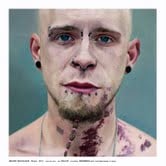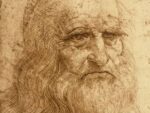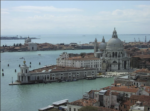PhotoReload (In-Humans) / Mauro Maugliani

Nello spazio Roomberg, al piano terra del grattacielo Baccari, si inaugura la seconda tappa della rassegna PhotoReload. Al 17. piano saranno esposti invece i 16 dipinti di Mauro Maugliani.
Comunicato stampa
ROOMBERG PROJECT SPACE di ROMBERG ARTE CONTEMPORANEA
PRESENTA
ALESSANDRO BAVARI / SIMONE SCHIESARI / PERSEFONE ZUBCIC / VIDEO DI UMBERTO CORNI
IN PhotoReload (IN-HUMANS)
A cura di ITALO BERGANTINI e ALESSANDRO TRABUCCO
INAUGURAZIONE SABATO 3 DICEMBRE 2011 ORE 17-20
ROOMBERG project space / Viale Le Corbusier 39 - Torre Baccari - ground floor / LATINA
Periodo: 3 DICEMBRE 2011 / 29 GENNAIO 2012
orario di galleria: lunedì 16-19,30 / martedì - sabato 10-13 / 16-19,30 / lunedì mattina su appuntamento
info: T. e F. +39 0773 604788 – M. +39 334 7105049
e.mail: [email protected] / sito: www.romberg.it
Sabato 3 dicembre nello spazio ROOMBERG, al piano terra del grattacielo Baccari, si inaugura la seconda tappa della rassegna PhotoReload. Pensata e costruita per ROOMBERG project space vuole tracciare un percorso omogeneo di ricerca sull’attuale 'stato dell’arte' della fotografia e della videoarte, incentrato soprattutto sul concetto di 'analisi' e di 'ricarica' (Reload - quindi una sorta di 'presa di coscienza') in relazione ad un pensiero digitale che condiziona sempre di più la vita contemporanea.
Obiettivo delle 5 mostre è presentare lavori fotografici e video nei quali la presenza dell’elaborazione digitale risulterà essere a volte determinante, ma mai predominante, a volte soltanto pensata ma non attuata, ciò significa che la tecnica adottata da ciascun artista accoglie le potenzialità offerte dalle nuove tecnologie senza esserne dominata, ottenendo risultati al confine tra il reale e l’immaginario, sino alla sensazione di non riuscire ad individuare la natura originaria dell’immagine stessa.
La seconda mostra, dal titolo IN-HUMANS, presenta i lavori fotografici di Alessandro Bavari, Simone Schiesari, Persefone Zubcic e un video di Umberto Corni. Soggetto privilegiato della loro ricerca è il corpo umano, ma non interpretato in chiave “post”, come andava di moda negli anni ’90, e nemmeno “fumettistico”, come potrebbe far pensare il titolo. Ad accomunare tutti i lavori è anche l’utilizzo di un classico bianco e nero, rigoroso e puro, utilizzato per mostrare, senza ridondanze cromatiche, un mondo in continua evoluzione e trasformazione.
In mostra la fotografia visionaria di Alessandro Bavari, che riproduce in digitale un mondo abitato da esseri che di umano hanno solo le sembianze e che compiono azioni apparentemente automatiche ed incomprensibili; i primissimi piani, realizzati rigorosamente in analogico, di Simone Schiesari, volti tumefatti e deformati, come fossero il risultato di qualche oscuro esperimento scientifico; gli scatti ed autoscatti digitali della fotografa croata Persefone Zubcic, dove il corpo viene mostrato in tutta la sua cruda realtà, senza alterazioni né ritocchi a migliorarne l’aspetto, ma colti nella loro naturale bellezza o decadenza.
Il video di Umberto Corni, dal titolo Contrasto, ci cala in enigmatiche ed inquietanti atmosfere hitchcockiane, degne delle migliori pellicole noir degli anni Sessanta. Sono volti femminili imperturbabili, in primi, primissimi piani e dettagli, consumati da una luce quasi abbagliante, un bianco e nero dalle intense tinte espressioniste.
ROOMBERG PROJECT SPACE ROMBERG ARTE CONTEMPORANEA
presents
ALESSANDRO BAVARI / SIMONE SCHIESARI / PERSEFONE ZUBCIC / VIDEO DI UMBERTO CORNI
in PhotoReload (IN-HUMANS)
organized by ITALO BERGANTINI and ALESSANDRO TRABUCCO
Inauguration Saturday 3rd December 2011 from 5 p.m. to 8 p.m.
ROOMBERG project space / Viale Le Corbusier 39 - Torre Baccari - ground floor / LATINA
Period: 3rd DECEMBER 2011 / 29 JANUARY 2012
Gallery times: Monday 4 p.m. to 7.30 p.m. / Tuesday to Saturday 10 a.m. to 1 p.m. / 4 p.m. to 7.30 p.m. / Monday mornings by appointment only
info: T. e F. +39 0773 604788 – M. +39 334 7105049
e.mail: [email protected] / sito: www.romberg.it
Saturday 3rd December in the ground floor ROOMBERG space in the Baccari tower we are inaugurating the second stage of the PhotoReload exhibition. Ideated and created for the ROOMBERG project space, this exhibition seeks to map out a homogenous journey of research into the present “state of the art” of photography and videoart, centred mainly on the concept of “analysis” and “recharge” (Reload - a sort of “awareness”) in relation to digital thought which is conditioning our modern life more and more.
The aim of the 5 exhibitions is to present photographic work and videos where the presence of digital elaboration is sometimes determining but never predominant, sometimes merely thought of but not carried out, this means that the techniques used by each artist accept the potential offered by new technologies without being dominated by it, obtaining results which lie on the border between real and imaginary, to the point where one has the sensation of not being able to identify the original nature of the image itself.
The second exhibition, called IN-HUMANS, presents the photographic work of Alessandro Bavari, Simone Schiesari, Persefone Zubcic and a video by Umberto Corni. The privileged subject of their research is the human body, but not interpreted in “post” key, as was fashionable in the 1990’s, nor in a “cartoon” one, as the title might imply. The works have in common the use of a classical black and white, rigorous and pure, used to show, without chromatic redundancy, a world which is in continual evolution and transformation.
Alessandro Bavari’s visionary photography is exhibited, which reproduces in digital a world inhabited by beings which merely look human and who carry out apparently automatic and incomprehensible actions; Simone Schiesari’s close ups, rigorously created in analogue, swollen and deformed faces, as if they were the result of some obscure scientific experiment; the digital shots and auto-shots of the Croatian photographer Persefone Zubcic, where the body is shown in all its harsh reality, without any alteration or retouching to make it look better, but rather caught in its natural beauty or decadence.
Umberto Corni’s video, called Contrasto (Contrast), lowers us into enigmatic and disquieting Hitchcock-like atmospheres, worthy of the best “noir” films from the sixties. These are imperturbable female faces, close up and consumed by a nearly blinding light, a black and white which has intense expressionistic hues.
ROMBERG Arte Contemporanea
MAURO MAUGLIANI
FACE OFF
a cura di Italo Bergantini e Paolo Balmas
Inaugurazione sabato 3 DICEMBRE 2011 ore 17-20
ROMBERG Arte Contemporanea / Viale Le Corbusier 39 - Torre Baccari / 17° Piano / LATINA
Periodo: 3 DICEMBRE 2011 / 29 GENNAIO 2012
orario di galleria: lunedì 16/19,30 – dal martedì al sabato 10/13 – 16/19,30
info: T. e F. +39 0773 604788 – M. + 39 334 7105049
e.mail: [email protected] / sito: www.romberg.it
SABATO 3 DICEMBRE 2011 SARÀ MAURO MAUGLIANI, ALLA SUA PRIMA IMPORTANTE PERSONALE, CON UN PROGETTO COMPOSTO DA 16 DIPINTI REALIZZATI A OLIO SU TELA, A OCCUPARE GLI ARTICOLATI SPAZI DELLA ROMBERG ARTE CONTEMPORANEA AL 17° PIANO DELLA TORRE BACCARI.
Ad onta di ogni evidenza classificare come “ritratti” i 16 dipinti esposti da Mauro Maugliani in questa sua personale é inesatto e perfino fuorviante. Anche se ciò che abbiamo di fronte sono, di fatto, dei volti umani resi con impressionante precisione i requisiti che tradizionalmente fanno di un’immagine un “ritratto” sono tutti volutamente evitati. Nessuna messa in posa dignificante, nessuna inquadratura sapiente, nessun emblema di qualificazione sociale, nessuno scavo psicologico dei tratti somatici, e, a volerla dir tutta, neppure quella complicità inespressa e deviata che, con la mediazione della tela e del cavalletto, si stabilisce immancabilmente tra artista e modello durante il rituale delle “sedute” a studio.
Il pittore del passato, che ancora vive nell’immaginario di tutti noi, riceveva una commissione e se ne sentiva onorato, ma non poteva sapere in anticipo chi lo avrebbe interpellato, Maugliani al contrario sceglie i suoi soggetti a loro insaputa e li insegue con determinazione finché non giunge con loro ad un accordo. Avrà il consenso di fare un gran numero di scatti e tra questi ne verrà scelto uno che costituirà il vero punto di partenza per la creazione di un dipinto il più oggettivo possibile.
Gli “antiritratti” così ottenuti, tuttavia, contrariamente a quanto ci si potrebbe attendere non hanno né la freddezza della foto segnaletica, né la veridicità allucinatoria dell’opera iperrealista. Per una sorta di trasmutazione ottengono semmai risultati in qualche modo opposti: chi li osserva non può fare a meno di trasformarsi in un attentissimo indagatore spontaneamente portato a scoprire e interpretare indizi sulla persona rappresentata che gli si rivelano molto più numerosi di quanto avrebbe pensato. Indizi relativi alla condizione sociale, al carattere, alla provenienza e persino agli umori momentanei che in questo o quell’attimo possono disturbare una tensione costante o un qualche progetto lungamente meditato.
Quale sia il segreto di quest’alchimia non è facile a dirsi, ma di certo ha a che fare con una sorta di filtraggio che, per fasi successive, elimina le scorie ideologiche, i pregiudizi e le indebite proiezioni che ci portiamo appresso nel relazionarci con gli altri sia pure per il solo tramite dello sguardo.
Se la “società dello spettacolo” e il flusso ininterrotto dei media hanno fatto dell’immagine di ognuno di noi, che lo voglia o no, uno stereotipo già codificato, non potrà che essere ancora un’immagine a riposizionarci correttamente rispetto all’altro da noi. “Face off”, faccia a faccia, per Maugliani non vuol dire altro che questo.
(Mauro Maugliani è nato a Tivoli nel 1967).
ROMBERG Arte Contemporanea
MAURO MAUGLIANI
FACE OFF
Organized by Italo Bergantini and Paola Balmas
Inauguration Saturday 3rd DECEMBER 2011 from 5 p.m. to 8 p.m.
ROMBERG Arte Contemporanea / Viale Le Corbusier 39 - Torre Baccari / 17th floor / LATINA
From: 3rd DECEMBER 2011 / 29th JANUARY 2012
Opening times: Monday 4 p.m./7.30 p.m. – from Tuesday to Saturday 10 a.m./1 p.m. – 4 p.m./7.30 p.m.
info: T. e F. +39 0773 604788 – M. + 39 334 7105049
e.mail: [email protected] / sito: www.romberg.it
SATURDAY 3rd DECEMBER 2011 MAURO MAUGLIANI PRESENTS HIS FIRST IMPORTANT PERSONAL PROJECT MADE UP OF 16 PAINTINGS, OILS ON CANVAS, WHICH WILL OCCUPY THE ARTICULATED SPACES IN ROMBERG ARTE CONTEMPORANEA ON THE 17th FLOOR OF THE BACCARI TOWER.
In spite of all the evidence, classifying these 16 paintings exhibited by Mauro Maugliani as “portraits” is incorrect and even misleading. Even though what we see are, in fact, human faces rendered with impressive precision, the requirements which traditionally make an image into a “portrait” are all purposefully avoided. There is no dignifying pose, no trained arrangement, no emblem of social qualification, no psychological markings in the facial traits, and, if all must be said, not even that unexpressed and deviated complicity which, through the mediation of the canvas and easel, always establishes itself between the artist and model during the ritual of “sittings” in the studio.
The painter of the past, who still lives in everyone’s imagination, received a commission and felt honoured by it, but he could not know beforehand who was going to call for his services, Maugliani, on the other hand, chooses his subjects without them knowing about it and he follows them with determination until he reaches an agreement with them. He receives permission to take a great number of photographs and from these one will be chosen as the real point of departure for the creation of a painting which will be as objective as possible.
The “anti-portraits” thus obtained, however, do not contain, as one might expect, either the coldness of the signal photograph or the hallucinatory veracity of a hyper-realistic work of art. By way of a sort of transmutation they somehow take on opposite effects: the person looking at them cannot help but become an attentive investigator who is spontaneously drawn to find and interpret clues about the person portrayed and these clues become far more numerous than they would ever have thought. Clues related to social condition, to character, to their origins and even to transitory moods which at one moment or the next can disturb a constant tension or some long premeditated project.
It is not easy to say what the secret behind this alchemy is, it certainly has something to do with a sort of filtering which in successive phases eliminates the ideological wastage, the prejudices and the unjust projections which we carry with us in our relations with others, be it only through the intermediary of expression.
If our “show society” and the uninterrupted flow of the media have made of everyone’s image, whether we like it or not, a codified stereotype, it will have to be another image which repositions us correctly in relation to the other. “Face Off”, face to face, for Maugliani, it cannot mean anything other than this.
(Mauro Maugliani was born in Tivoli in 1967).



